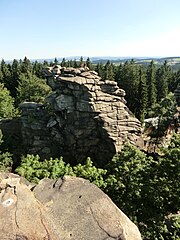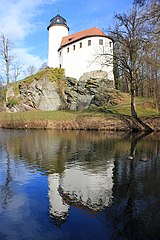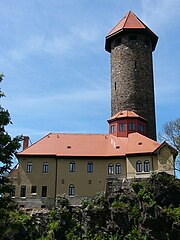Waldenburg (noble family)
The Lords of Waldenburg were a Meissnian - Thuringian noble-free noble family.
history
It is assumed that the Lords of Waldenburg descended from the noble noble family of those of Wartha. These had their headquarters in the diocese of Naumburg , which is known today as the Warta desert .
The Lords of Wartha left the area on the Unstrut and founded a new rule southeast of Altenburg between 1165 and 1175 . This happened in the course of the development of the country and the German settlement in the east on behalf of Emperor Friedrich I (called Barbarossa). There, the built pleißenländische Landrichter Hugo von Wartha together with the Imperial Marshal Rudolph fire the castle in Waldenburg (Saxony) .
The district judge Hugo von Wartha, first mentioned in a document in 1172, accompanied King Friedrich I "Barbarossa" on trips and took part in several court days. His descendants named themselves after their new seat "von Waldenburg".
Around 1200, the Lords of Waldenburg expanded their territory to include the castles in Selva (Ore Mountains) and Greifenstein and later Scharfenstein (1250). Around 1300 the rule of Rabenstein , which was connected with the bailiwick of the Benedictine monastery of St. Marien zu Chemnitz and with jurisdiction over the city of Chemnitz , came into the hands of the Waldenburgs.
The rule of Rabenstein with the bailiwick rights represented an important connection between the ancestral seat Waldenburg and the possessions in the upper Zschopau valley. By the middle of the 14th century, the Waldenburgs had developed into economically and politically influential feudal lords through the creation of a self-contained domain. In the middle of the 14th century, the lords of Waldenburg owned the lords and castles of the same name, Waldenburg , Wolkenstein , Rabenstein , Auerbach and the lordship of Thum . Greifenstein Castle, which was still in existence at the time, belonged to the Thum rulership . At times they are said to have owned the Schellenburg ( Schellenberg Castle) in what was then Schellenberg / today's Augustusburg. The castles Rauenstein and Zschopau were also in their possession. Rauenstein was previously owned by the von Schellenberg family.
In the 14th century the family lost part of their possessions: Johann I von Waldenburg, who killed a citizen of Chemnitz in 1371, had to sell the Rabenstein manor and castle to the Chemnitz Benedictine monastery in 1375. In 1378, as a result of the legacy between Johannes I. von Waldenburg and Friedrich von Schönburg- Hassenstein , the Schönburgers became the lords of the castle and town of Waldenburg.
In 1415, according to a traditional description of the Council of Constance, Messrs Anarg von Waldenburg and Veit I von Schönburg (the latter owner of the Waldenburg, he was besieged in this castle by the Margraves of Meissen in 1388 during the Rabenstein feud) took part in the council the Jan Hus was burned.
In 1473 (or 1474) the male line died out.
Keep of the Waldenburg (lower part medieval: humpback cuboid from the Staufer period )
Auerbach castle tower as the remainder of the lost castle
people
- Men named Hugo von Wartha are attested between 1172 and 1199. One was a district judge in the Pleißenland .
- Around 1199 Hugo von Wartha (probably the son of the castle founder, see Warta ) first called himself Hugo von Waldenburg .
- In 1205 a Heinrich von Wartha is mentioned in a document as the castle man of the Burgraves of Meißen .
- Conrad von Wartha-Waldenburg , who died after 1216, is considered to be Hugo's son .
- His son Hugo von Waldenburg (before 1216-1262) is referred to in 1241 as a knight and 1254 as Vogt of the Remse monastery .
- Isengard von Waldenburg was probably born around 1180/85 and died between 1224/42. She could have been the daughter of Hugo von Wartha, but this has not been proven. Isengard was married to Vogt Heinrich V. von Reichenbach-Greiz (from the later Reuss family ) in 1209 , but the marriage remained childless.
- Around 1300 lived Anarg von Waldenburg – Wolkenstein (1254–1317), who was married to Adelheid von Plauen , a great niece of Isengard.
- The children of Anarg are Kunigunde von Wolkenstein (before 1300 - after 1322), who with Heinrich III. von Wildenfels was married and Heinrich von Wolkenstein (1301–1343), who was married to Euphemia.
- In 1385 Hans von Waldenburg transferred the village and the Arnsfeld estate to the church in Selva .
See also
- House Hohenlohe-Waldenburg-Schillingsfürst , Franconian noble family, not related to the tribe
- House Schönburg-Waldenburg , Meissen-Bohemian noble family
- Dynasty bracteates / Lord of Waldenburg on Wolkenstein
- Waldenburg (Prussian noble family) , illegitimate descendants of Prince August of Prussia (1779–1843) and his partner Karoline Friederike Wichmann , ennobled as von Waldenburg
literature
- Gerhard Cheap : The Lords of Waldenburg and their part in the colonization of the Pleißenland . in: Archäologische Mitteilungen aus dem Bezirk (Chemnitz), 1990, pp. 3–9
- Britta Günther : The Lords of Waldenburg and their rule Waldenburg . in: Sächsische Heimatblätter 43 (1997) 1, pp. 8-10
- Wolf-Dieter Röber: Chapter "Excursion II", In: Series of publications Heft 3 ", Museum and Art Collection Schloss Hinterglauchau, City of Glauchau, 1981, GDR, p. 30 (discussion on the location of the headquarters of the Lords of Wartha / Waldenburg at" Wartha bei Naumburg "or at" Wartha / Harthau near Schloss Neukirchen in the Erzgebirge ")
Individual evidence
- ↑ K. Fleck, Ralph Zenker and others: Waldenburg. On the history of the city and its sights: local history museum and natural history cabinet Waldenburg. Revised edition. Edited by the Waldenburg city administration. Waldenburg 1990, p. 9
- ^ Matthias Donath : 100 Years of Waldenburg Castle 1912–2012. Zwickau 2012, ISBN 978-3-98-11118-7-3 , p. 4
- ↑ K. Fleck, Ralph Zenker and others: Waldenburg. On the history of the city and its sights: local history museum and natural history cabinet Waldenburg. Revised edition. Edited by the Waldenburg city administration. Waldenburg 1990, p. 9
- ^ Walter Schlesinger , edited by Thomas Lang: Contributions to the history of the city of Glauchau. Edited by Enno Bünz. Thelem Verlag, Dresden 2010, p. 45.
- ^ Matthias Donath : 100 Years of Waldenburg Castle 1912–2012. Zwickau 2012, ISBN 978-3-98-11118-7-3 , p. 4
- ↑ K. Fleck, Ralph Zenker and others: Waldenburg. On the history of the city and its sights: local history museum and natural history cabinet Waldenburg. Revised edition. Edited by the Waldenburg city administration. Waldenburg 1990, p. 9
- ↑ K. Fleck, Ralph Zenker and others: Waldenburg. On the history of the city and its sights: local history museum and natural history cabinet Waldenburg. Revised edition. Edited by the Waldenburg city administration. Waldenburg 1990, p. 10
- ^ Matthias Donath : 100 Years of Waldenburg Castle 1912–2012. Zwickau 2012, ISBN 978-3-98-11118-7-3 , p. 4
Web links
- Ralf Jung: The Lords of Waldenburg , (Members - Women - Isengard von Waldenburg)





